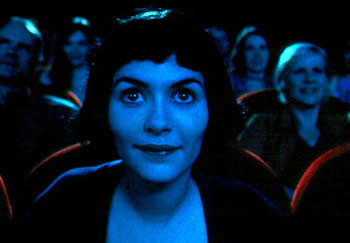![[MetroActive Movies]](/movies/gifs/movies468.gif)
[ Movies Index | Show Times | Santa Cruz Week | MetroActive Central | Archives ]
Paris Pixie
The new French hit 'Amélie' promotes a Paris that doesn't quite exist
By Richard von Busack
DO PEOPLE really love Amélie, or is it Paris that they love? This hit was so highly regarded in France as inevitably to seem smaller when it arrived here. Some critics--the wittiest being J. Hoberman in the Village Voice--suspected the film of being racist. Director Jean-Pierre Jeunet (late of the Jeunet-Caro team that made The City of Lost Children) has scrubbed out some, but not all, of the city's graffiti and hidden many, but not all, of its nonwhite residents. Jeunet favors the Moped, the Metro and the train over the cars that really rule the city.
Amélie is all nostalgia, but it's not as heinous a vandalizing of Paris as seen in Moulin Rouge. Jeunet shows the Parisians the working-person's Paris they'd like to think exists (and does exist, in spots). Amélie's Paris is racked by musette accordion (some of it badly synthesized). The interiors are so dowdy, they're chic: loads of pre-1954 furniture and appliances. The citizens are old French-movie people: gruff, shrugging brutes; stout, wheezing landladies with colorful pasts; and, of course, sexless, angelic little gamines looking for love.
Our heroine, a moony pixie named Amélie (Audrey Tautou), is a counter-girl at the Two Windmills Cafe. When Princess Diana dies (ending a life, as writer Julian Barnes noted, that was less like a candle in the wind than a bloody great chandelier), Amélie is moved to follow the princess' example as a helper of others. The waitress becomes a matchmaker, a spy and a prankish avenger upon the rude. Her several little projects make up this film's plot. At about the halfway point, Amélie begins to notice Nino (Mathieu Kassovitz). He's also eccentric: a collector of lost photo-booth photos, a part-time employee at a porn store, sometimes the man wearing the skeleton suit at the Faire du Trone carnival.
The film is best in fleeting images, such as the scene on a black-and-white television of a gospel guitarist. And Tautou does look fetching in a little Zorro outfit. However, Amélie is sketch comedy taffy-pulled into a full-length movie. To the credulous, Tautou is the second coming of Audrey Hepburn. However, her strange deadpan face, dark black eyes and self-inflicted haircut suggest that she was sired by Rowan Atkinson's Mr. Bean.
And the film may not be of more importance than a Mr. Bean episode. In one scene, Amélie walks a blind man to his Metro station. She rattles off the details of the ordinary sights along the way. The scene made me happy, not for the good deed or the girl who did it, but for seeing the street--the roasting chickens in the deli window, the dog on the pavement. When Amélie leaves the blind man at the Metro station, he's flooded with golden light, grateful to having been touched by an angel. To put it mildly, not everyone will dissolve so.
Copyright © Metro Publishing Inc. Maintained by Boulevards New Media.
![]()

Moulin Meddler: Amélie (Audrey Tautou) sticks her nose into everybody's business in Jean-Pierre Jeunet's 'Amélie.'
Amélie (R; 120 min.), directed by Jean-Pierre Jeunet, written by Jeunet and Guillaume Laurant, photographed by Bruno Delbonnel and starring Audrey Tautou and Mathieu Kassovitz, opens Friday at the Nickelodeon in Santa Cruz.
From the November 21-28, 2001 issue of Metro Santa Cruz.